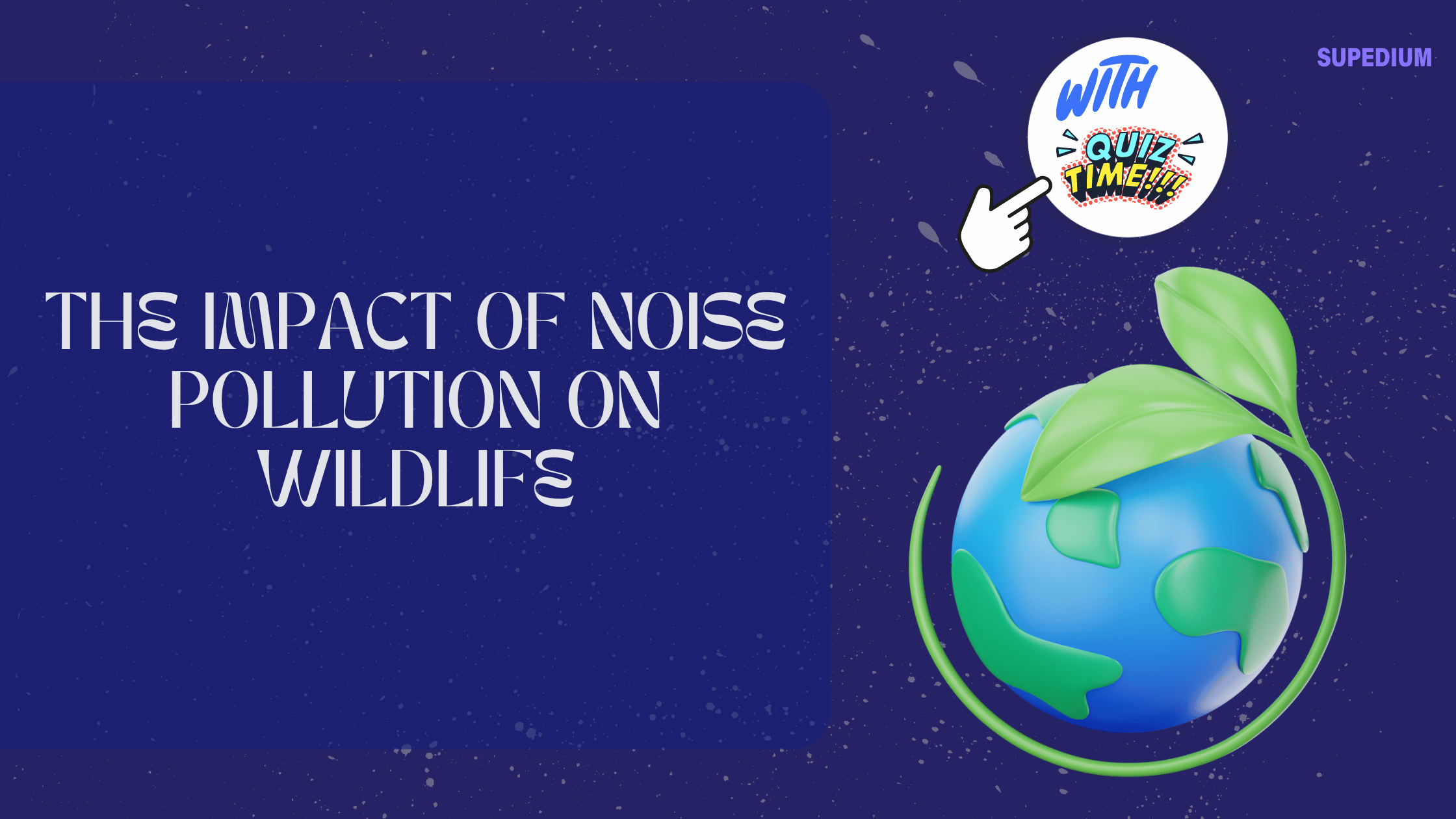Table of Contents
![]()
I. Introduction
Noise pollution, defined as disruptive or harmful levels of sound in the environment, is an increasingly pervasive issue in modern societies. Sources range from urban traffic and industrial activities to agricultural machinery and even natural phenomena. This noise pollution can significantly impact wildlife, affecting their health, behavior, and survival.
Wildlife encompasses a broad spectrum of species, each playing a crucial role in their respective ecosystems. From the tiniest insects to the largest mammals, these creatures contribute to the balance and functionality of natural systems. Understanding how noise pollution affects wildlife is essential for developing effective conservation strategies and mitigating adverse impacts on biodiversity.
II. Understanding Noise Pollution
A. Sources of Noise Pollution
- Urban Sources: In urban areas, traffic noise, construction activities, and public events are major contributors. Constant honking, engine sounds, and the rumble of machinery can create a cacophony that pervades natural habitats.
- Industrial Sources: Factories, power plants, and other industrial facilities emit high-decibel sounds from machinery, equipment, and processes. This noise can extend far beyond the immediate vicinity of the facility.
- Agricultural Sources: Machinery used in farming, such as tractors and harvesters, as well as the noise from livestock, contributes to the overall noise pollution. These sounds can disturb nearby wildlife and alter their natural behaviors.
- Natural Sources: Natural events like storms or volcanic eruptions also produce significant noise, but their impacts are often less studied compared to anthropogenic sources.
B. Characteristics of Noise Pollution
- Frequency: Noise pollution includes a range of frequencies, from low-frequency rumbles to high-frequency squeals. Different wildlife species are sensitive to different frequencies, and their ability to perceive and react to noise can vary significantly.
- Intensity: Measured in decibels, the intensity of noise determines its potential impact on wildlife. Higher decibel levels are more likely to cause harm or disturb natural behaviors.
- Duration and Variability: Continuous noise versus intermittent noise can have different effects. For instance, a steady sound may lead to habituation, while unpredictable bursts might cause heightened stress responses.
III. Effects of Noise Pollution on Wildlife
A. Behavioral Changes
- Altered Communication: Many animals rely on sound for communication, including mating calls and territorial signals. Noise pollution can mask these calls, leading to reduced mating success, disrupted social interactions, and territorial disputes.
- Increased Stress and Anxiety: Persistent noise pollution elevates stress hormones in wildlife. This chronic stress can result in behavioral changes such as increased aggression, fearfulness, or altered activity patterns, potentially impacting survival and reproduction.
- Disruption of Feeding and Foraging: Noise pollution can interfere with an animal’s ability to locate food. For example, predators might struggle to hear the sounds of their prey, and herbivores might find it harder to detect subtle environmental cues critical for foraging.
B. Physiological Impacts
- Hearing Damage: Exposure to high levels of noise can lead to hearing loss or impairment in wildlife, making it difficult for them to detect danger or communicate effectively. This hearing damage can increase their vulnerability to predators.
- Stress Response: Chronic exposure to noise pollution affects physiological stress responses, impacting overall health. This can lead to reduced reproductive success, stunted growth, and higher mortality rates.
- Impaired Navigation: Many species use sound for navigation, particularly those in aquatic environments. Noise pollution can disrupt migration patterns and cause disorientation, leading to increased mortality or displacement from critical habitats.
C. Ecological Consequences
- Disruption of Ecosystem Dynamics: Noise pollution can alter predator-prey relationships, with predators becoming less effective at hunting and prey becoming more vigilant or disoriented. This imbalance can affect entire food webs and ecosystem stability.
- Impact on Species Diversity: Certain species may thrive in noisy environments while others decline, leading to shifts in species composition. This can reduce overall biodiversity and alter ecosystem functioning.
- Long-term Population Effects: Persistent noise pollution can result in declines in population numbers and, in extreme cases, contribute to species extinction. The cumulative effects of noise on health, behavior, and reproduction can lead to significant population-level impacts.
IV. Case Studies
A. Terrestrial Wildlife
- Birds: Urban noise pollution has been shown to affect songbirds, disrupting their mating calls and territorial signals. For instance, some bird species alter the pitch or volume of their songs to compensate for urban noise, which can have cascading effects on their mating success and territorial disputes.
- Mammals: Large mammals, such as elephants, experience stress from noise pollution caused by human activities like road construction. This stress can affect their social structures, migration patterns, and overall health.
B. Aquatic Wildlife
- Marine Animals: The sounds generated by shipping and naval activities impact marine animals, particularly whales and dolphins. These species use echolocation for communication and navigation, and noise pollution can interfere with their ability to find food, communicate, and navigate effectively.
C. Specific Regions
- Urban Environments: In cities, the constant hum of traffic and construction noise can significantly affect wildlife living in and around urban areas, altering their behavior and reducing their chances of survival.
- Natural Reserves and Protected Areas: Even in protected areas, noise pollution from surrounding human activities can penetrate and impact wildlife. This can compromise the effectiveness of conservation efforts and the health of these critical habitats.
V. Mitigation Strategies
A. Reducing Noise at the Source
- Policy and Regulations: Implementing noise ordinances and managing traffic can help reduce noise pollution. Regulations targeting industrial noise and restrictions on certain noisy activities can also contribute to quieter environments.
- Technological Innovations: Advances in technology, such as quieter machinery and improved design practices, can reduce noise emissions from industrial and transportation sources.
B. Creating Noise Barriers
- Physical Barriers: Constructing sound barriers, such as walls or vegetation, can help shield wildlife from noise pollution. These barriers can be particularly effective in reducing noise from roads and industrial areas.
- Acoustic Design Improvements: Using sound-dampening materials and designing quieter equipment can mitigate noise pollution at the source. Innovations in acoustic engineering can play a significant role in reducing environmental noise.
C. Conservation and Management Practices
- Designating Quiet Zones: Establishing areas where noise is minimized can help protect sensitive wildlife. These zones can be particularly important in breeding or feeding grounds.
- Monitoring and Research Programs: Ongoing research and monitoring are crucial for understanding the effects of noise pollution on wildlife. This data can inform conservation strategies and policy decisions.
- Public Awareness and Education: Raising awareness about the impact of noise pollution on wildlife can encourage public support for noise reduction initiatives and foster more considerate behaviors.
VI. Future Research Directions
A. Identifying Knowledge Gaps
- Species-Specific Studies: More research is needed to understand how different species are affected by noise pollution. This includes studying the impacts on less well-known species and understanding species-specific sensitivities.
- Long-Term Ecological Impact Studies: Investigating the long-term effects of noise pollution on ecosystems and species populations will help predict future impacts and guide conservation efforts.
B. Innovative Research Methods
- Advances in Monitoring Technology: New technologies, such as acoustic sensors and drones, can provide more accurate and detailed data on noise pollution and its effects on wildlife.
- Interdisciplinary Approaches: Combining expertise from ecology, acoustics, and behavioral science can lead to a more comprehensive understanding of noise pollution impacts and more effective mitigation strategies.
VII. Conclusion
The impact of noise pollution on wildlife is profound and multifaceted, affecting behavior, physiology, and ecological dynamics. Addressing this issue requires a multi-pronged approach, including reducing noise at its source, creating effective noise barriers, and implementing conservation practices. Continued research and public awareness are essential for mitigating the effects of noise pollution and protecting wildlife. By taking action now, we can help ensure a healthier, more balanced environment for all species.






Be the first to comment